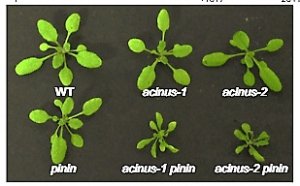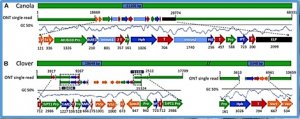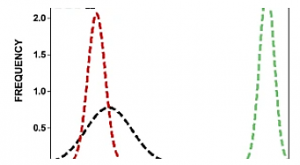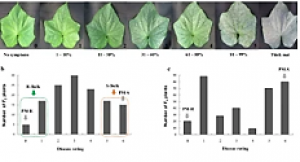O-GlcNAc modification plays important roles in metabolic regulation of cellular status. Two homologs of O-GlcNAc transferase, SECRET AGENT (SEC) and SPINDLY (SPY), which have O-GlcNAc and O-fucosyl transferase activities, respectively, are essential in Arabidopsis but have largely unknown cellular targets. Here we show that AtACINUS is O-GlcNAcylated and O-fucosylated and mediates regulation of transcription, alternative splicing (AS), and developmental transitions. Knocking-out both AtACINUS and its distant paralog AtPININ causes severe growth defects including dwarfism, delayed seed germination and flowering, and abscisic acid (ABA) hypersensitivity.
Despite more than 2,000-fold variation in genome size, key features of genome architecture are largely conserved across angiosperms. Parasitic plants have elucidated the many ways in which genomes can be modified, yet we still lack comprehensive genome data for species that represent the most extreme form of parasitism. Here, we present the highly modified genome of the iconic endophytic parasite Sapria himalayana Griff
Molecular characterization of genetically modified plants can provide crucial information for the development of detection and identification methods, to comply with traceability, and labeling requirements prior to commercialization. Detailed description of the genetic modification was previously a challenging step in the safety assessment, since it required the use of laborious and time-consuming techniques.
Sclerotinia Stem Rot (SSR) caused by the oxalic acid (OA)-secreting necrotrophic fungal pathogen Sclerotinia sclerotiorum, causes significant yields losses in the crop Brassica sps. Oxalate oxidase (OxO) can metabolize OA to CO2 and H2O2. Degradation of OA during the early phase of fungal–host interaction can interfere with the fungal infection and establishment processes.
Flowering and plant height are the key life history traits. These are crucial for adaptation and productivity. Current investigations aimed to examine genotypic differences governing days to flowering, maturity and plant height under contrasting day-length conditions; and identify genomic regions governing the observed phenotypic variations. An association panel comprising 195 inbred lines, representing natural (NR) and derived (DR) forms of Brassica rapa (AA; 2n = 20), was evaluated at two sowing dates and two locations, representing different day-length regimes.
Nitrogen (N) and carbon (C) are essential elements for plant growth and crop yield. Thus, improved N and C utilisation contributes to agricultural productivity and reduces the need for fertilisation. In the present study, we find that overexpression of a single rice gene, Oryza sativa plasma membrane (PM) H+-ATPase 1 (OSA1), facilitates ammonium absorption and assimilation in roots and enhanced light-induced stomatal opening with higher photosynthesis rate in leaves. As a result, OSA1 overexpression in rice plants causes a 33% increase in grain yield and a 46% increase in N use efficiency overall.
Soybean cyst nematode (SCN, Heterodera glycines, Ichinohe) is the most devastating pathogen of soybean. Understanding the genetic basis of SCN resistance is crucial for managing this parasite in the field. Two major loci, rhg1 and Rhg4, were previously characterized as valuable resources for SCN resistance. However, their continuous use has caused shifts in the virulence of SCN populations, which can overcome the resistance conferred by these two major loci. Reduced effectiveness became a major concern in the soybean industry due to continuous use of rhg1 for decades.
Nicotiana tabacum is a non‐food herb that has the potential to be utilized as bio‐factory for generating medicines, vaccines or valuable small metabolites. To achieve these goals, the improvement of genetic tools for pre‐designed genome modifications is indispensable. The development of CRISPR/Cas nucleases allows the induction of site‐specific double‐strand breaks to enhance homologous recombination‐mediated gene targeting (GT). However, the efficiency of GT is still a challenging obstacle for many crops including tobacco.
Tomato accession T431 produces stigmas under relatively high temperatures (> 27 °C, the average temperature in Harbin, China, in June–August), so pollen can rarely reach the stigma properly. This allows the percentage of male sterility exceed 95%, making the use of this accession practical for hybrid seed production. To investigate the mechanism underlying the exserted stigma male sterility, the morphological changes of, anatomical changes of, and comparative endogenous hormone (IAA, ABA, GA3, ZT, SA) changes in flowers during flower development of tomato accessions DL5 and T431 were measured.
Hypocotyl growth is a vital process in seedling establishment. Hypocotyl elongation after germination relies more on longitudinal cell elongation than cell division. Cell elongation is largely determined by the extensibility of the cell wall. Here, we identified a spontaneous mutant in cucumber (Cucumis sativus L.), sh5.1, which exhibits a temperature-insensitive short hypocotyl phenotype. Genetic analysis showed that the phenotype of sh5.1 was controlled by a recessive nuclear gene. CsSh5.1 was mapped to a 57.1 kb interval on chromosome 5, containing eight predicted genes.


 Curently online :
Curently online :
 Total visitors :
Total visitors :









